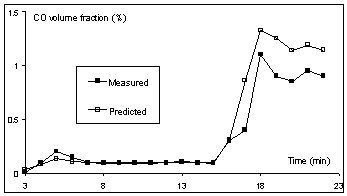APPLYING THE LOCAL EQUIVALENCE RATIO CONCEPT TO FIRE FIELD MODELS
The primary aim of this project is to develop a practical engineering fire field model that is capable of predicting the generation and spread of CO within compartment fire environments. To be of practical use, the technique attempts to rely on the minimum of experimental data.
The majority of practical fire field modelling applications have been concerned with the spread of heat and smoke in complex structures and so the combustion process has either been ignored or greatly simplified. In cases where combustion is ignored the fire is treated as a simple time dependent prescribed source of heat and smoke. Generally, when combustion is included, it is approximated using relatively simple one-step reaction mechanisms for gaseous or liquid fuels such as methane. Recent work has attempted to extend these capabilities to include the prediction of fire spread in enclosures through the use of zone and field models incorporating the rate of flame spread over the solid fuel through the use of thermal analysis, empirical formulations or direct use of Cone Calorimeter data. A different approach has been developed where the flame spread is governed by a set of partial differential equations that describe and link gas-phase and solid-phase behaviour.
However, while advances have been made in predicting the spread of flame over solid surfaces, the weakest component of fire field modelling is its ability to predict the generation and spread of toxic fire products, in particular CO.
In this project a “simple” CFD method is presented to predict the generation of toxic gases within enclosure fires. The technique makes use of the equivalence ratio concept while the fire source is represented by a heat release rate model. The concentrations of carbon monoxide, carbon dioxide, hydrocarbon, soot and oxygen throughout the compartment are calculated based on the concept of equivalence ratio. The technique has been used to simulate two experiments and it is shown that model predictions are in good agreement with experimental results.
The concept of the equivalence ratio, developed for zone modelling, is a useful tool to describe the fire conditions within compartments. The generation of CO is well correlated to the equivalence ratio concept for both hood experiments and reduced room fire experiments. Based on this concept, several zone models have been developed to predict the average concentration of CO in the upper layer for room fires.
However, a possible weakness of using this technique within zone models is that the technique predicts similar upper layer CO concentrations for reduced-scale and full-scale room fires when the ventilation conditions (GER—global equivalence ratio) are similar. In reality, the distributions of CO in the upper layer for the two different fire scenarios can be quite different. The reason for these differences in CO distributions may be that the local equivalence ratios are different within the two types of room fire scenarios. As typical zone models are generally one-dimensional in nature, these differences are difficult to resolve. However, fire field models, which are three-dimensional in nature, have the ability to resolve spatial variation of every relevant dependent variable.
In this work, the concept of local equivalence ratio is applied to field modelling. The correlation of CO generation rate to the equivalence ratio, based on small-scale combustion apparatus, is used to predict the CO concentration in full-scale room fires. The volumetric heat release rate model is used to represent the heat sources.
To apply the present method the following properties are required. The fuel chemical composition is required to calculate the stoichiometric value. The heat release rate and the fuel loss rate within the room are also required. Finally, the correlation of the yield rates of the species to the equivalence ratio is required. Two simulations of two fire tests have been performed. The fuels for the two tests are polypropylene (PP) and wood cribs respectively. The predictions of CO and CO2 in the test with PP are depicted below. The predictions of temperatures, global equivalence ratio and the volume fractions of CO and CO2 are in good agreement with the experimental data while the predictions of hydrocarbon and smoke production in the compartment opening are relatively poor. In the simulation in which wood cribs were used as fuel, the predictions of temperatures are somewhat higher than the measurements but follow the measured trend. The simulation produced reasonably good predictions of species concentrations in the flaming combustion stage. The simulations suggest that the models developed in this study have potential to predict the combustion products of the full-scale enclosure fires.


Figure: Predicted (empty) and measured (solid) CO (left) and CO2 (right) volume fraction as a function of time (min) in the test with polypropylene
For information relating to the SMARTFIRE fire field model visit our SMARTFIRE web pages. You will find a range of publications relating to SMARTFIRE and our other combustion research on the FSEG Publications pages both CMS press and external publications.

